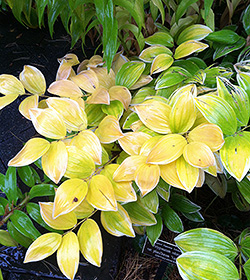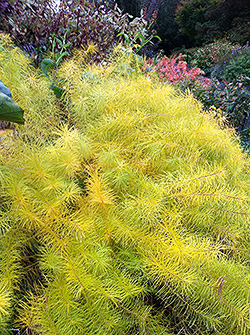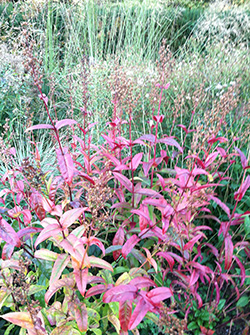Shades of Autumn
Posted in Horticulture on November 13 2014, by Sonia Uyterhoeven
Sonia Uyterhoeven is NYBG‘s Gardener for Public Education.

When we think of autumnal shade in our gardens, we always look to woody plants. It is the season when trees monopolize our attention. In New England and the rest of the northeast, a thriving tourist industry kicks into full swing for three weeks around this time, paying homage to the brilliance of fall foliage. New Englanders pray for the warm days and cool nights which will provide the ideal conditions for a colorful show.
While most of us are looking up at this time of the year, looking down isn’t a bad idea, either. There are many perennials that compete with the brilliance of the trees. I was perusing the gardens two weeks ago admiring some of the best fall performers, and now I’d like to share some of the best fall candidates for the home gardener.

One perennial that fades like a champion is variegated Japanese Solomon’s seal (Polygonatum odoratum var. pluriflorum ‘Variegatum’). Variegated Japanese Solomon’s seal grows 18–24 inches tall on graceful, arching stems. Its bright green, ovate-shaped leaves are edged with white. This shade-loving perennial spreads by rhizomes to form small colonies, and it is happiest in dappled light with moist, well-drained soil.
In the spring, fragrant white tubular flowers adorn the stems. The flowers are followed by blue-black berries in autumn. Toward the end of the season, the foliage turns a handsome yellow. When the foliage and stems starts to fade, gardeners can give the stems a gentle tug and they will release from the rhizome, making this one an easy plant to tidy up at the end of the season.
Moving from a soothing butter yellow, we come to the electric gold of the threadleaf bluestar (Amsonia hubrichtii). This perennial is a staple in many native and municipal plantings because of its ease and elegance. Feathery, needle-like foliage adorns this clump-forming perennial. It reaches 3 feet tall and acts more like a small, uniform shrub than a perennial in your garden.

In the spring, threadleaf bluestar produces small, blue, star-shaped flowers. However, the flowers are insignificant—it’s the foliage on this perennial that creates the talking piece. If you are a flower person, there is always the compact Amsonia ‘Blue Ice’, which is a hybrid that has the broader-leaved eastern bluestar or willow amsonia (Amsonia tabernaemontana) as the parent. Regardless of which one you choose, you will end up with dazzling golden yellow fall foliage with tinges of red. The threadleaf bluestar is one of my favorites.
For contrast, include foxglove-beardtongue or Husker Red penstemon (Penstemon digitalis ‘Husker Red’) in your garden. This penstemon has burgundy-green foliage and white tubular flowers in late spring to early summer. It is another stalwart for the perennial garden. In the fall, the burgundy foliage takes on a ruby red hue.
All three perennials are winners of the Perennial Plant Association’s Perennial Plant of the Year award. The variegate Japanese Solomon’s seal was awarded the honor in 2013, the threadleaf bluestar in 2011, and ‘Husker Red’ penstemon in 1996.
The Perennial Plant Association bases the award on several criteria including low maintenance, adaptability, pest and disease resistance, and multi-seasonal appeal. These three perennials certainly fit the bill. There is also good news for those of you living in deer country—while the deer devour the variegated Japanese Solomon’s seal, the beardtongue and the bluestar are deer resistant. All three are great additions to your garden.

